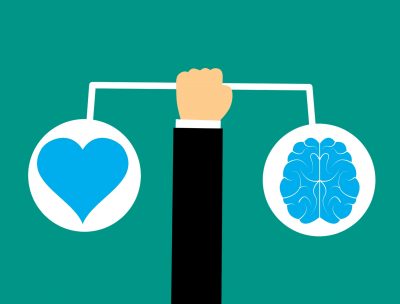7.1 Components of Emotion

Emotions help us navigate the complex social landscape of our lives.
Learning Objectives
- Define the concept of emotions and describe the degree to which emotions are universal.
- Compare and contrast basic emotions with self–conscious emotions.
- Identify and explain at least one research study or theory that supports the universality of emotions.
- Identify how culture shapes our emotions.
- Define the term display rules of emotions.
- Differentiate between amplification and qualifying display rules
- Identify at least one cultural difference in display rules.
- Explain the ingroup advantage when interpreting emotions.
It is impossible to imagine life without emotion. We treasure our feelings—the joy at a soccer game, the pleasure of the touch of a loved one, or the fun with friends on a night out. Even negative emotions are essential, such as the sadness when a loved one dies, the anger when violated, the fear that overcomes us in a scary or unknown situation, or the guilt or shame when our mistakes are made public. Emotions color life experiences and give those experiences meaning and flavor. To communicate and function effectively as employees, students, parents, and citizens in a global community, we must understand the function of emotions and how culture shapes our emotions.
The words emotion and mood are sometimes used interchangeably, but psychologists use these words to refer to two different things. An emotion refers to a transient, automatic, neurophysiological event that is relatively intense and that occurs in response to something we experience. Mood refers to a prolonged, less intense, affective state that does not happen in response to something we experience. Mood states do not carry the intentionality associated with emotion (Beedie, Terry, Lane, & Devonport, 2011). There are three components associated with emotion:
- Physiological arousal (involuntary)
- Behavioral
- Cognitive
Three components of emotion and universal emotions (open YouTube video in new tab)
Emotions are rapid information-processing systems that help us act with minimal thinking (Tooby & Cosmides, 2008). Problems associated with birth, battle, death, and seduction have occurred throughout evolutionary history, and emotions evolved to aid humans in adapting to those problems rapidly and with minimal conscious cognitive intervention. Without emotions, we could not make rapid decisions concerning whether to attack, defend, flee, care for others, reject food, or approach something useful—all of which were functionally adaptive in our evolutionary history and helped us survive.
For instance, drinking spoiled milk or eating rotten eggs negatively affects our welfare. The emotion of disgust helps us act immediately by either avoiding these substances in the first place or expelling them through vomiting. This adaptive response supports survival, enabling us to act without lengthy deliberation. Similarly, fear facilitates survival by triggering the “fight or flight” response to threats such as predators or dangerous heights. Sometimes, pausing to calculate the cost-benefit ratio of actions could result in grave consequences. Emotions evolved to bypass such delays, ensuring immediate responses to environmental challenges.
Interestingly, cultural differences exist in how disgust is expressed and triggered. For example, certain insects like crickets or mealworms are considered delicacies in some cultures, while others find consuming them repugnant. This demonstrates that while the physiological basis of disgust is universal, its elicitors are shaped by cultural norms and practices (Rozin & Fallon, 1987).

The emotion of disgust protects us from toxins and contamination, of the physical and moral variety.
Physiological Component of Emotion
Emotions prepare the body for action by simultaneously activating specific systems and deactivating others to prevent the chaos of competing systems, enabling coordinated responses to environmental stimuli (Levenson, 1999). For example, fear initiates a cascade of physiological changes: the release of adrenaline, pupil dilation, increased heart rate, and reduced digestion. These changes are essential for responding to threats.
However, emotions do not always result in direct action. Context plays a critical role in determining whether action is taken. For example, fear in a social setting, such as public speaking, might trigger the physiological responses of dry mouth and sweating without leading to escape behavior, as the perceived consequences of fleeing outweigh the instinct to avoid discomfort. Research supports this notion, highlighting how emotions prepare but do not mandate action (Baumeister, Vohs, DeWall, & Zhang, 2007; Matsumoto & Wilson, 2008).
Different emotions also have distinct physiological signatures. Joy, for instance, often triggers parasympathetic activation, leading to reduced heart rate and muscle relaxation. Conversely, anger can increase cardiovascular activity, preparing the body for potential confrontation (Ekman, Levenson, & Friesen, 1983).
Interestingly, there are cultural variations in physiological responses. Studies show that while the physiological mechanisms are largely universal, cultural norms can influence how these responses are expressed or suppressed. For example, East Asian cultures, which emphasize emotional moderation, may show lower physiological arousal for emotions like anger compared to Western cultures (Kitayama & Markus, 1994).

Behavioral Component of Emotion
Emotions not only prepare us for immediate action but also shape our future behavior. For instance, disgust experienced from spoiled milk often leads to precautionary measures, such as checking expiration dates or inspecting food for freshness. Similarly, the joy associated with personal accomplishments, such as acing an exam or receiving recognition at work, motivates individuals to replicate the behaviors that led to success. Negative emotions, such as guilt or shame, can influence future behaviors by encouraging reparative actions. For example, guilt after neglecting a friend’s needs might motivate more attentive behavior in the future, strengthening social bonds (Baumeister, Stillwell, & Heatherton, 1994).
Emotions are expressed verbally and nonverbally. Facial expressions, gestures, body posture, and vocal tone convey emotional states. Research demonstrates that even subtle nonverbal cues can communicate emotions effectively. For example, people often identify anger or fear by observing facial expressions or body language (de Gelder, 2006; Tamietto et al., 2009). Studies using the Facial Action Coding System (FACS) have shown that emotions such as happiness, sadness, anger, and surprise have universally recognizable facial expressions, underscoring the evolutionary basis of emotional expression (Ekman & Friesen, 1978). Additionally, tone of voice can convey emotional nuances—a cheerful tone can indicate happiness, while a flat tone might suggest sadness or disinterest.
Notably, cultural norms influence how emotions are displayed. In collectivist cultures such as Japan, emotional expression may be more subdued to maintain group harmony, whereas in individualist cultures like the United States, emotions may be expressed more openly (Matsumoto, 1990). In some cultures, emotional expression is also tied to social roles and expectations. For example, studies suggest that in many Asian cultures, leaders are expected to show emotional restraint as a sign of wisdom and control. Meanwhile, in Western contexts, expressing emotions may be considered a sign of authenticity and approachability (Tsai, Knutson, & Fung, 2006). Furthermore, gender norms within cultures can shape emotional expression—women are often socialized to express emotions like sadness or empathy more openly, while men may be encouraged to suppress vulnerability and emphasize emotions like anger or pride (Fischer & Manstead, 2000).
The ability to interpret and express emotions effectively is crucial for interpersonal communication and social functioning. Emotional intelligence, a concept popularized by Goleman (1995), emphasizes recognizing, understanding, and managing emotions in oneself and others. High emotional intelligence has been linked to better conflict resolution, stronger relationships, and greater professional success, illustrating how deeply interconnected emotions and behavior are in shaping human experiences.
Cognitive Component of Emotion
Emotions are deeply intertwined with cognition, influencing how we appraise, interpret, and remember events. For instance, when walking down a trail, mistaking a climbing rope for a snake triggers physiological responses such as increased heart rate and rapid breathing. Upon closer inspection, the realization that it is a rope prompts the body to deactivate these responses. This cognitive appraisal, shaped by past experiences and cultural knowledge, moderates the emotional response.
Moreover, emotions enhance memory by serving as “neural glue” that binds facts to the feelings experienced during events (Wang & Ross, 2007). This explains why individuals recall emotionally charged moments, such as weddings or traumatic incidents, more vividly than mundane ones. Emotions act as markers of salience, guiding which memories are stored and prioritized for recall. For instance, the amygdala, a brain structure associated with emotional processing, plays a crucial role in enhancing the consolidation of emotional memories (McGaugh, 2004). This phenomenon is evident in flashbulb memories—highly detailed and vivid recollections of significant events, such as where one was during a natural disaster or a major political event.

Cognitive appraisals (evaluation) play a key role in interpreting emotional responses to situations.
Additionally, emotions influence our attitudes, values, and beliefs. A positive emotional connection to an event or person can foster favorable attitudes, while negative experiences may lead to aversion or distrust. For example, a student’s pride and achievement after excelling in a subject may shape a lifelong interest or career path. At the same time, frustration or embarrassment during a public speaking event may lead to avoidance of similar situations in the future. These emotional connections help form the foundation of our personal identity and social interactions.
Cognitive appraisals of emotions are not static but are shaped by cultural norms and personal experiences. For example, in cultures that value emotional restraint, such as Japan, individuals may reinterpret anger-inducing situations to align with social expectations of harmony (Matsumoto, 1990). Conversely, cultures that emphasize individualism, like the United States, may encourage individuals to openly express and validate their emotional experiences. This dynamic interplay between culture and cognition highlights the malleability of emotional responses and their interpretations.
However, emotions can also interfere with critical thinking. Intense emotions, such as anger or fear, often narrow cognitive focus and impair decision-making. For instance, fear can lead to tunnel vision, making it difficult to consider alternative perspectives or solutions. On the other hand, mild positive emotions can broaden attention and facilitate creative problem-solving (Fredrickson, 2001). This “broaden-and-build” theory suggests that positive emotions enhance cognitive flexibility and resilience, enabling individuals to explore novel ideas and strategies.
Emotions also play a pivotal role in moral reasoning and ethical decision-making. Feelings of empathy, guilt, or outrage often guide judgments about fairness and justice. For example, witnessing an injustice may evoke moral outrage, motivating actions to rectify the situation. At the same time, excessive emotional involvement can lead to biases, such as favoritism or prejudice, underscoring the need for balance between emotion and rationality in decision-making processes.
Key Takeaways
Emotions are integral to human survival, influencing physiological responses, behavior, and cognition. While their evolutionary roots lie in solving adaptive problems, emotions also shape cultural practices, interpersonal relationships, and individual well-being. Understanding emotions requires a multidisciplinary approach, integrating evolutionary psychology, cultural psychology, and cognitive science.
Media Attributions
- image-aecc474f-cecd-4016-8b98-f4ee9190b47f © Suprising_Media is licensed under a CC BY (Attribution) license
- image-b5c2d3b6-34b1-4450-b133-2e1244a897ae © allenjaelee is licensed under a CC BY (Attribution) license
- image-07d9a9ab-c020-4b8e-99b6-7b78f408208a © bijayyadav is licensed under a CC BY (Attribution) license
- emotion_cognition-e1657239670507 © Mohamad Hassan is licensed under a Public Domain license

